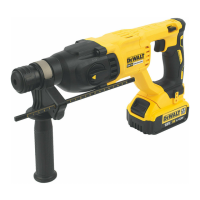11
ENGLISH
3. Release the button to lock rod into position. When drilling
with the depth rod, stop when end of rod reaches surface
ofmaterial.
Bit and Bit Holder
WARNING: Burn Hazard. ALWAYS wear gloves when
changing bits. Accessible metal parts on the tool and bits
may get extremely hot during operation. Small bits of
broken material may damage barehands.
The hammerdrill can be fitted with different bits depending on
the desired application. Use sharp drill bitsonly.
Bit Reccomendations
• For wood, use twist bits, spade bits, power auger bits or
holesaws.
• For metal, use high-speed steel twist drill bits or holesaws.
Use a cutting lubricant when drilling metals. The exceptions
are cast iron and brass which should be drilleddry.
SDS-Plus Bit Holder (Fig.D)
NOTE: Special adapters are needed to use the SDS-Plus bit
holder with straight shank bits and hexagonal screwdriver bits.
Refer to OptionalAccessories.
To insert a drill bit or other accessory:
1. Insert the shank of the bit about 19mm into SDS-Plus tool
holder
11
.
2. Push and rotate bit until it locks in place. The bit will be
securelyheld.
3. To release bit, pull the sleeve
14
back and remove thebit.
OPERATION
Instructions for Use
WARNING: Always observe the safety instructions and
applicableregulations.
WARNING: To reduce the risk of serious personal
injury, turn tool off and disconnect battery pack
before making any adjustments or removing/
installing attachments or accessories. An accidental
start-up can causeinjury.
Proper Hand Position (Fig. E)
WARNING: To reduce the risk of serious personal injury,
ALWAYS use proper hand position asshown.
WARNING: To reduce the risk of serious personal
injury, ALWAYS hold securely in anticipation of a
suddenreaction.
Proper hand position requires one hand on the side handle,
with the other hand on the mainhandle. Hold tool firmly with
both hands to control the twisting action of thedrill.
Overload Clutch
In case of jamming of a drill bit, the drive to the drill spindle
is interrupted by the overload clutch. Due to the resulting
forces, always hold the tool with both hands and take a
firmstance. After the overload, release and depress the trigger
to re-engagedrive.
Mechanical Clutch
With a mechanical clutch the indication that the clutch
has activated will be an audible ratcheting together with
increasedvibration.
WARNING: Drill may stall if overloaded causing a sudden
twist. Always expect the stall. Grip the drill firmly to control
the twisting action and avoidinjury.
Operation Modes (Fig. F)
WARNING: Do not select the operating mode when the
tool isrunning.
CAUTION: Never use in Rotary Drilling or Rotary
Hammering mode with a chisel bit in the bit holder.
Personal injury and damage to the the tool mayresult.
Your tool is equipped with a mode selector dial
6
to selectthe
mode appropriate to desiredoperation.
Symbol Mode Application
Rotary Drilling
Screwdriving
Drilling into steel, wood
andplastics
Rotary Hammering
Drilling into concrete
andmasonry
Hammering only Lightchipping
To select an operating mode:
1. Depress the mode selector release button
7
.
2. Rotate the mode selector dial so that the arrow points to the
symbol corresponding for the desiredmode.
NOTE: The arrow on the mode selector dial
6
must be pointing
at a mode symbol at all times. There are no operable positions
inbetween. It may be necessary to briefly run the motor after
having changed from 'hammering only' to 'rotary' modes in
order to align thegears.
Performing an Application (Fig. A, G)
WARNING: TO REDUCE THE RISK OF PERSONAL
INJURY, ALWAYS ensure workpiece is anchored or
clamped firmly. If drilling thin material, use a wood “back-
up” block to prevent damage to thematerial.
WARNING: Always wait until the motor has come to
a complete standstill before changing the direction
ofrotation.
1. Choose and install the appropriate chuck, adapter, and/or
bit onto to the tool. Refer to Bit and BitHolder.
2. Using the mode selector dial
6
, selectthe mode
appropriate to desired application. Refer to
OperationModes.
3. Adjust the side handle
3
asnecessary.
4. Select the direction ofrotation using the forward/reverse
button
4
. When changing the position of the control
button, be sure the trigger isreleased.

